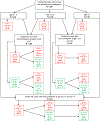Factors associated with long-term cardiac dysfunction in neonatal lupus
- PMID: 31672776
- PMCID: PMC11545888
- DOI: 10.1136/annrheumdis-2019-215900
Factors associated with long-term cardiac dysfunction in neonatal lupus
Abstract
Objectives: Cardiac manifestations of neonatal lupus (NL) have been associated with significant morbidity and mortality; however, there is minimal information on long-term outcomes of affected individuals. This study was initiated to evaluate the presence of and the risk factors associated with cardiac dysfunction in NL after birth in multiple age groups to improve counselling, to further understand pathogenesis and to provide potential preventative strategies.
Methods: Echocardiogram reports were evaluated in 239 individuals with cardiac NL: 143 from age 0-1 year, 176 from age >1-17 years and 64 from age >17 years. Logistic regression analyses evaluated associations of cardiac dysfunction at each age group with demographic, fetal and postnatal factors, using imputation to address missing data.
Results: Cardiac dysfunction was identified in 22.4% at age 0-1 year, 14.8% at age >1-17 years and 28.1% at age >17 years. Dysfunction in various age groups was significantly associated with male sex, black race, lower fetal heart rates, fetal extranodal cardiac disease and length of time paced. In 106 children with echocardiograms at ages 0-1 year and >1-17 years, 43.8% with dysfunction at age 0-1 year were also affected at age >1-17 years, while the others reverted to normal. Of children without dysfunction at age 0-1 year, 8.9% developed new dysfunction between ages >1 and 17 years. Among 34 with echocardiograms at ages >1-17 years and >17 years, 6.5% with normal function at age >1-17 years developed dysfunction in adulthood.
Conclusions: Risk factors in fetal life can influence cardiac morbidity into adulthood.Although limited by a small number of cases, cardiac dysfunction in the first year often normalises by later childhood. New-onset dysfunction, although rare, can occur de novo after the first year.
Keywords: antibodies; cardiac dysfunction; neonatal lupus; outcomes.
© Author(s) (or their employer(s)) 2020. No commercial re-use. See rights and permissions. Published by BMJ.
Conflict of interest statement
Competing interests: None declared.
Figures
References
-
- Buyon JP, Friedman DM, Buyon JP, et al. Neonatal lupus. In: Lahita RG, Tsokos G, Buyon JP, et al, eds. Systemic lupus erythematosus. 5th Edition. New York, NY: Academic Press, 2010: 541–71.
-
- Moak JP, Barron KS, Hougen TJ, et al. Congenital heart block: development of late-onset cardiomyopathy, a previously underappreciated sequela. J Am Coll Cardiol 2001;37:238–42. - PubMed
-
- Eliasson H, Sonesson S-E, Sharland G, et al. Isolated atrioventricular block in the fetus: a retrospective, multinational, multicenter study of 175 patients. Circulation 2011;124:1919–26. - PubMed
Publication types
MeSH terms
Supplementary concepts
Grants and funding
LinkOut - more resources
Full Text Sources
Medical


